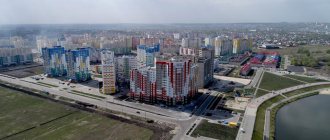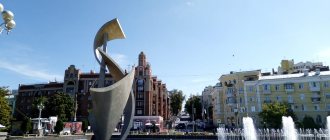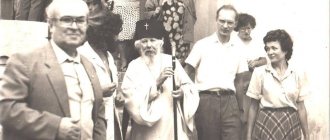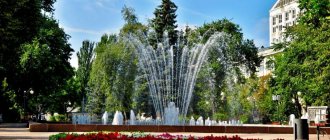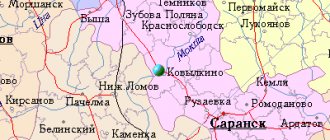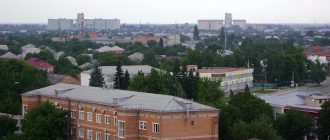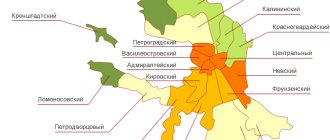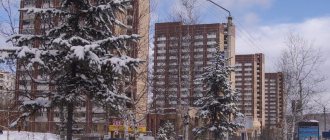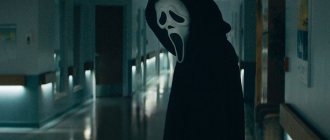- Reports and messages
- Miscellaneous
- Penza city
Each region on the territory of the Russian Federation is unique and individual in its own way.
It is known that the fortress city of Penza was founded back in 1663, which was a guard post in the southeast of the Russian state. The city of Penza is located on the Sura River, at the confluence of the Penza River.
City `s history
The emergence of the city is connected, first of all, with the growth and development of Rus' as a state under the reign of Tsar Ivan the Terrible. To this day, it is not known exactly what served as the basis for the name of the city. Some scientists believe that it comes from the name of the Penza River, from which the fortress and then the fortified city got its name. In the 17th century, freight roads passed through the city, along which ambassadors from Moscow passed through Penza, Saransk and many other cities.
Number and composition of the population
As of 2022, the city's population is about 550 thousand people. The ethnic composition of the city consists of representatives: 87% are Russians, 8% are Tatars, 4% are Mordovians, less than 1% are Ukrainians. In addition to the above nationalities, on the territory of the Penza region there are such as: Chuvash, Armenians, Belarusians, Azerbaijanis, Gypsies, Germans, Georgians, Moldovans, Chechens, Bashkirs, Mari and Poles.
Infrastructure and attractions of the city
The circus building was built in 1965, and reconstruction has been carried out since 2011. On the territory of the city there is a Sports Palace, founded in 1970.
In the late 90s, the following churches were built: Christ the Savior according to the plans of the architect G.P. Ivanov, Saints Peter and Paul according to the plans of the architect B.V. Churlyaev, Archangel Michael, located on Victory Square in 2000, St. Sergius of Radonezh in 2002 on Novozapadny cemetery according to the plans of the architect V.E. Gerasimova.
In addition, the city has the Regional Drama Theater named after. A.V. Lunacharsky, founded in 2010, whose architects are A.V. Chibirev and I.A. Kudryashov.
On the eastern side of the city, rest houses and sanatoriums were built, as well as the building of the Penza State Agricultural Academy, built in 1933.
As for monuments, there are quite a lot of them in the city. Among them are monuments to famous personalities: M.Yu. Lermontov, V.I. Lenin, K. Marx, as well as the obelisk of Glory, founded in 1967 according to the design of the artist A.A. Oya, the monument to military and labor Glory, located on Victory Square, and many others.
The leading industry in Penza is mechanical engineering, and the light, food, pharmaceutical and pulp and paper industries are also widely developed.
Where is Penza
If you look on the map where the city of Penza is located, you will find it in the very center of the European part of Russia. Distance from Moscow – 629 km to the southeast. Located on the M5 highway connecting the capital and Chelyabinsk. You can get there from Moscow by train, car or plane.
Penza is located on the Volga Upland. The city stretches along both banks of the Sura, one of the tributaries of the Volga. It is compactly located – it stretches from north to south for 19 km, and from east to west – for 25 km. Penza is located on 7 hills. The height difference can reach 100 m. The southern part of the city is especially high - it is located on the hilly bank of the Sura. In addition to this river, Penza, Penzyatka, Ardym, Moika, Staraya Sura, and Barkovka flow through the city. That's why there are many bridges in the city.
Center for Theater Arts "Meyerhold House"
Center for Theater Arts "Meyerhold House"
Penza
The Center for Theater Arts in Penza became the first memorial in Russia and the world dedicated to Vsevolod Meyerhold. It opened on February 24, 1984 in the house where the famous theater director lived.
Exhibition “Meyerhold. Chronicles" is dedicated to the life and work of Vsevolod Meyerhold. Here, museum guests can see rare photographs, letters, texts of plays with notes from the director, and his personal belongings. The rooms have preserved original furnishings: a piano, an antique secretary, Viennese chairs. Costumes that were created for Meyerhold's productions are also on display here. The world's first monument to the director was erected in the courtyard.
The Theater Arts Center includes the Dr. Dapertutto Theater. His troupe consists only of men - professional actors who sing and play musical instruments live, and use elements of choreography, plastic arts and acrobatics in their performances. The concept of the theater was born from the statement of Vsevolod Meyerhold: “Theater is a fantastic spectacle, scenery, masks in the literal and figurative sense, grotesquery, stage metaphors and refined body plasticity.” “Doctor Dapertutto” is the pseudonym of Meyerhold himself. The director took it from the fairy tale “Adventures on New Year's Eve” by Ernst Theodor Amadeus Hoffmann.
Penza map
If you are wondering where Penza is on the map of Russia, you need to look southeast of Moscow. It is located approximately at the latitude of Samara, north of Saratov. Nearby are cities such as Tambov, Saransk, Syzran, Ulyanovsk.
A map of Penza shows that the city is crossed from west to east by the M5 highway, and from north to south by the Sura River. It covers an area of more than 300 km2. Three main streets pass through the center: Volodarskogo, Kirov and Moskovskaya. The latter is notable for being pedestrian. That's why it is also called Penza Arbat.
Penza is a very green city. Almost in the center there is a Botanical Garden and a large zoo. The climatic resort of Akhuny is located nearby. The city itself has many parks and squares, so it is considered one of the greenest in Russia.
Museum of Ilya Ulyanov
Museum I.N. Ulyanova
Penza
The museum, which occupies the former service building of the Noble Institute, is dedicated to Vladimir Lenin’s father, teacher and public figure Ilya Ulyanov. On the ground floor of the building there is a permanent exhibition “Ilya Nikolaevich Ulyanov in Penza and his entourage.” Here you can see books of the 19th century from the institute library, original furniture of that time, and personal belongings of Ulyanov. Museum guests will also learn about the teacher’s scientific research, and about the people who surrounded him in Penza - his students, colleagues, friends.
The entire second floor of the building is occupied by the exhibition “The World of the Penza Estates: Family and Life of the 19th–20th Centuries.” It tells about the daily life of nobles, officials, merchants and commoners. Here viewers can see the traditional furnishings of a peasant hut, furniture from a noble living room, and the vestments of an Orthodox priest. The exhibition is accompanied by audio recordings of ancient Penza songs.
Population of Penza
The population of Penza grew rapidly in the 20th century. If by the end of the 19th century it was only 60 thousand people, now the city is in 35th place in terms of population in Russia. It is home to 520,300 people.
The largest number of residents was in 1989 - 542,612 people, and in 1993 - 552,000 people. After this, the population slowly declines. There were small increases in 1996, 1999, and also in 2010-2016. Over the past 4 years, the population has gradually decreased by 4 thousand people.
The city grew at the expense of the suburbs, so the majority of the population comes from rural areas. But the level of culture of the residents is high. Penza has several higher educational institutions, many museums, and cultural events, exhibitions, and festivals. There is still debate about what to call the residents of Penza: Penza residents or Penzyaks. The second word is traditional. But since the 90s, local residents prefer the name Penza residents. This word has taken root in the media and on television.
Penza Art Gallery named after. K.A. Savitsky
Penza Regional Art Gallery named after K.A. Savitsky
Penza
Art gallery named after. Konstantin Savitsky - the largest and one of the oldest museums in the Penza region - opened in January 1892. The basis of the exhibition was a collection of paintings, which was bequeathed to the city by Governor General Nikolai Seliverstov. The gallery was named after him. In October of the same year, an exhibition of the Itinerants opened at the museum. The newspaper “Penza Vedomosti” reported: “... “The Capture of a Snow Town” by V.I. was exhibited. Surikov, “Life Everywhere” by N.A. Yaroshenko, “The Sinner” by V.D. Polenova, “Time of Passion” by G.G. Myasoedov, etc.”
In 1897, the artist Konstantin Savitsky came to Penza. He became the first director of the Seliverstov gallery and art school, which had opened in the city by that time. Boys and girls could study there together. Savitsky invited the sculptor Konstantin Klodt, painters Nikolai Grandkovsky and Pyotr Korovin as teachers.
Konstantin Savitsky headed the art gallery until 1905. In 1955, by decision of the Presidium of the Supreme Soviet of the RSFSR, the museum and school were named after him. An entire section of the exhibition is dedicated to the artist’s work. Also in separate rooms are works by Ivan Goryushkin-Sorokopudov and Aristarkh Lentulov. Both painters were born in the Penza region.
The museum's collection includes works by Ivan Shishkin, Alexey Savrasov, Mikhail Vrubel, Ivan Aivazovsky and other Russian artists of the 18th–20th centuries. Also here you can see a valuable collection of paintings from the 17th century, created by masters from Holland, France, and Germany.
Sights of Penza
Penza is one of the oldest cities in Russia that has preserved the atmosphere of the past. It is worth strolling through the streets of the Old Town and admiring the ancient buildings. The following attractions of Penza deserve attention:
- Meat passage;
- regional drama theatre;
- Sura embankment;
- defensive rampart;
- Trinity Convent;
- People's Observatory;
- Museum of Local Lore;
- a light and music fountain and a cuckoo clock in the park on Moskovskaya Street;
- observation deck on the Kremlin hill;
- Victory Monument;
- Church of the Transfiguration.
Folk Art Museum
Folk Art Museum
Penza
The Penza Museum of Folk Art opened in 1975. Until 1992 it was called the exhibition hall. The exhibition included samples of folk art created in different techniques: knitted scarves made of goat's down, carved and painted wood products, carpets, ceramic dishes, embroidery, artistic forging.
The museum is located in a wooden building from the mid-19th century. Its first owner was court councilor Varvara Zagoskina, a relative of the writer Mikhail Zagoskina. Then the estate was bought by Otto von Einem, brother of the famous confectioner, “chocolate king” Ferdinand Theodor von Einem. After him and until the revolution, the house belonged to the family of the famous Penza timber merchant Stepan Tyurin.
During Soviet times, the building housed an orphanage, a hospital, and apartments for military personnel and their families. In the 1970s, the house was restored and recognized as a monument of wooden architecture.
History of Penza
The history of Penza is interesting because the city was started to be built by the Circassian Cossacks in 1663. At first it was a wooden fortress that guarded the southern approaches to Moscow from nomads. Only at the beginning of the 18th century did it receive the status of a city, and by 1790 it became the center of the Penza province.
The city has experienced a lot: Tatar raids, uprisings of Stepan Razin and Emelyan Pugachev. But it developed as a cultural and commercial center. Already at the end of the 19th century there were two gymnasiums, an art school, more than 150 small factories, and a water supply system. Modern Penza is interesting not only for its attractions. This small town attracts guests with its amazing atmosphere, abundance of greenery and friendly residents.
Rating: 5 / 5
PENZA. Historical sketch
The beauty and attractiveness of Penza lies in its unique landscape, cut in two by the calm water surface of the Sura, which is the main compositional axis of the city. More than a dozen steel and reinforced concrete bridges, supported by massive supports, span the river and connect its banks into a single urban organism. In summer, the beauty of Penza is complemented by a green sea of gardens, parks, public gardens, forest parks...
View of the city of Penza on the Sura R. to the North-East. Engraving from the 60s of the 18th century. Artist M. I. Makhaev.
The bright and original history of Penza at one time was awarded ringing epithets from the pens of the most eminent natives and guests of the city on Sura: poets I. M. Dolgoruky , D. V. Davydov , E. A. Evtushenko , academician F. I. Buslaev , critic V. G. Belinsky , writers M. E. Saltykov-Shchedrin , N. S. Leskov , A. G. Malyshkin and others.
Penza has a considerable age: it is older than the neighboring cities of Syzran and Samara , but younger than Saratov , Tambov , Saransk . Its foundation dates back to 1663, when a fortress was built on the southeastern outskirts of the Russian state, which was easy and unprotected prey for steppe nomads.
In May 1663, beyond the Lomovskaya guard line , built in the 1640s , on the river. Yuri Ermolaevich Kotransky arrived in Penza “to build a city . In a fairly short time, business people erected a wooden Kremlin, to the south of which there were settlements of service people - mounted and foot Cossacks, dragoons, gunners, collars, and to the north - settlements of the civilian population, small Icon of the Kazan Mother of God. Author of the photo: A.I. Dvorzhansky.artisans and traders.
By 1665, 3,300 people lived in Penza . As a blessing for the newly built city, Tsar Alexei Mikhailovich granted Penza an icon of the Kazan Mother of God , which was revered as miraculous. According to legend, in 1717 , during the Great Kuban Pogrom , Penza residents who were under siege appeared in front of the enemy army with this icon, which saved the city from destruction. For more than 200 years, the icon was kept in the Penza Cathedral , and is currently located in the Mitrofan Church .
In the first decades of its existence, Penza, which survived the raids of nomads, numerous natural disasters, and the triumph of the victory of Mikhail Kharitonov , an associate of Stepan Razin , was administered by the order of the Kazan Palace , and in the 18th century. found itself plunged into the abyss of all kinds of administrative and territorial reforms. Only on September 9, 1801, by decree of the Senate , Penza was declared a provincial city, being at the same time the center of the Penza district .
The residence of the governor, the highest government official in charge of public and government institutions, was located in Penza. The most famous in this field were F. L. Vigel (1801-1809), G. S. Golitsyn (1811-1815), M. M. Speransky (1816-1819), A. A. Panchulidzev (1831-1859), N. D. Seliverstov (1867-1873), P. D. Svyatopolk-Mirsky (1895-1898). Serving as governor in 1907-1910, I. F. Koshko left behind a book of memories .
In 1799, a bishop's see was located in Penza, which was first occupied by Archpastor Guy (1799-1808). For a short time in 1819, Innocent was the Penza bishop .
In Penza there was a system of government bodies generally accepted in Russia, which was formed in 1785 . The administrative body was the city duma, to which representatives of all classes were elected, the executive body was the city government. At their head was the mayor, who was elected from among the most honorable and eminent persons of the city. The first city mayor of Penza was the merchant of the 2nd guild E. F. Shulgin , and the last, elected already in 1917 , was commerce adviser D. V. Vyarvilsky . This post was occupied many times by: manufacturer P.V. Sergeev , grain merchant N.T. Evstifeev . An outstanding role in the development of the city was played by mayors F.E. Shvetsov , M.P. Balashov , D.V. and P.V. Kazitsyn .
Penza was traditionally located at the intersection of important trade routes, and by the end of the 19th century. received railway access in all directions: on October 11, 1874, traffic began on the Morshansk-Syzran section of the Syzran-Vyazma Railway , passing through Penza. This circumstance created good preconditions for economic and cultural development.
Factory of P.V. Sergeev.
Penza entrepreneurs created enterprises in the stationery, woodworking, cloth, leather, construction, metalworking, and food industries. Their products have repeatedly won gold and silver medals at All-Russian and international exhibitions.
Penza had a well-deserved reputation as one of the largest nests of the Russian nobility, personifying the power and glory of the state.
In Penza it was represented by the brilliant names of the Sheremetevs , Shuvalovs , Golitsyns , Kurakins , Tatishchevs , Trubetskoys , Dolgorukys , Suvorovs , Vorontsovs , Razumovskys and others, who elevated Russia in the eyes of the world community. At the same time, the epithet of a “merchant” city was firmly assigned to Penza.
At the beginning of the 18th century. The merchant class of the city was represented by 384 people , and at the end of the 19th century. - 859. The leading position in the commercial world of Penza was occupied by the Karpovs , Finogeevs , Sergeevs , Barsukovs , Kuzmins , Kuznetsovs, Tyurins , Evstifeevs , Ochkins , Pankovs and others, who entered the all-Russian and even world market.
The city had a fairly wide network of credit and financial institutions (a public bank, a branch of a state bank, a noble and peasant land bank, a number of commercial banks) that provided financial support for the production sector.
The cultural environment of the city was created by the oldest theater in our country ( 1793 ), the first national stationary circus of the Nikitin brothers ( January 1874 ), cultural societies and libraries named after. V. Belinsky and M. Yu. Lermontov, a large number of secular and religious educational institutions, as a result of which Penza had the proud title of “New Athens” .
Penza is one of the old Russian cities with a fairly developed and rich theatrical culture, which began to take shape in the estates of the noble Penza nobles Gorikhvostovs, Beketovs, Kozhins, Chemesovs, Arapovs and others. The large number of home theaters pushed Penza to third place in Russia after Moscow and St. Petersburg . The development of theatrical life in Penza was facilitated by I. N. Gorstkin , who in 1840 resumed staging performances in the former serf theater of G. V. Gladkov .
In 1896, local lovers of the performing arts D. S. Volkov , A. A. Kosminsky , S. S. Kalashnikov organized the People's Theater , in which the world famous V. E. Meyerhold . In 1921, the theater was named after A.V. Lunacharsky . The heyday of the Penza Drama Theater occurred in the 50-70s. , when the theater team toured Moscow four times. The creative rise of the theater was also facilitated by its wonderful actors and directors P. M. Kirsanov , L. A. Lozitskaya , S. M. Reingold , who were awarded the title of People's Artists of Russia.
The architectural appearance of Penza was formed mainly after 1785 , when the first rectilinear development plan in the history of the city was confirmed by the highest authority. Urban planning practice in Penza found its expression in government buildings, the bishop's and governor's houses, and the noble assembly, built in the last decades of the 18th century.
The architectural monuments include: a noble institute, an art school, a peasant land bank, the houses of A. A. Panchulidzev , F. P. Alferov , S. L. Tyurin . Church architecture is represented by the surviving buildings of the Trinity Convent , founded in 1690 , the Intercession and Transfiguration churches .
With the establishment on January 3, 1918, a new page opened in the chronicle of the city on Sura. New bodies of power were formed - provincial and city councils as part of various sectoral boards, and a city committee of the Bolshevik Party was elected. The new government nationalized enterprises of industry, construction, trade, banks, laying the foundation for the public sector of the economy, liquidated the previous classical and real educational structures, closed churches of all faiths (the closure of churches was accompanied by their destruction and the destruction of ancient cemeteries where prominent figures of culture, science and states).
In the first post-revolutionary years, Penza found itself in the epicenter of a civil war: peasant uprisings broke out in the villages of the province, and in May 1918, bloody battles took place in the city with the rebel troops of the Czechoslovak corps. A monument to these tragic pages in the history of Penza is the necropolis on Sovetskaya Square , where the Penza residents who defended the city are buried.
In the years before the Great Patriotic War, the production base in Penza was further developed: a confectionery, knitting, sewing, biscuit factories, a soft drink factory and a calculating machine factory were built, the production of bicycles and wristwatches, and high-grade paper for the publication of the Great Atlas of the World began.
At the same time, the educational, medical and cultural infrastructure was improved and expanded. Forestry, pedagogical, industrial, construction and other technical schools, a teacher's institute, children's and infectious diseases hospitals, and an anti-tuberculosis dispensary were created in Penza. On the initiative of doctor A.S. Barsukov, a maternity hospital was organized.
On February 4, 1939, the Penza region was formed . By that time, the city's population was 159.8 thousand people . the Penza Railway was formed , which later became part of the Kuibyshev Railway .
In the first years of the Great Patriotic War, Penza turned into one of the most powerful centers in the country for the production of mortar weapons: on the basis of local and food industry enterprises that existed in the city, equipment from factories evacuated from Orel, Voronezh, Simferopol, Kharkov and other cities was deployed. The patriotic upsurge of Penza residents in a critical period for the Fatherland was expressed in the collection of funds for the country's defense fund, the formation of fighting squads of the people's militia, the organization of front-line brigades, and the construction of the Penza defensive line.
More than 200 Penza residents were awarded the title of Hero of the Soviet Union . Among them are A. A. Krasnov , N. S. Pavlushkin , S. F. Kostychev , A. I. Merenyashev , G. V. Ternovsky and others.
The labor feat of the residents of Penza was also awarded by the Motherland: the bicycle factory - the Order of Lenin , the watch factory - the Order of the Patriotic War . For its great contribution to ensuring victory in the Great Patriotic War, Penza was awarded the Order of the Red Banner of Labor 1985 .
Modern Penza has great economic and cultural potential. Penza enterprises produce air and gas compressors, diesel engines of various capacities, industrial and household fittings and much more.
Penza can rightfully be called a student city. Penza State University , civil engineering and agricultural academies train highly qualified specialists. In the system of secondary specialized educational institutions of the city, the College of Land Management and Business stands out, founded in August 1820 as a horticulture school and awarded the Order of the Red Banner of Labor in 1945 when it was then a state farm-technical school.
Each city has a purely individual source of pride. The history of Penza took shape under a happy constellation of brilliant names:
writers - V. G. Belinsky , M. Yu. Lermontov , P. A. Vyazemsky , D. V. Davydov , M. E. Saltykov-Shchedrin , N. S. Leskova ;
composers - A. V. Kastorsky , A. A. Arkhangelsky , O. V. Grishin ;
directors - V. E. Meyerhold , S. M. Reinold ;
physicians - N. F. Filatova , G. A. Zakharyina , N. N. Burdenko , V. A. Oppel;
scientists - F. I. Buslaev , V. O. Klyuchevsky;
singers - A. A. Yakhontov , A. I. Mozzhukhin , I. M. Skobtsov , V. I. Kastorsky ;
artists - K. A. Savitsky , N. F. Petrova , I. S. Goyushkin-Sorokopudov , A. V. Lentulov , V. E. Tatlin;
filmmakers - I. I. Mozzhukhin , V. I. Pudovkin , L. V. Kosmatov , I. A. Schweitzer ;
military leader M. N. Tukhachevsky ;
cosmonauts - V. I. Patsaeva, A. M. Samokutyaeva .
The history of Penza and the memory of these people are immortalized in the exhibitions of the State United Museum of Local Lore, the art gallery named after. K. A. Savitsky, museums of V. O. Klyuchevsky, N. N. Burdenko and V. E. Meyerhold, museum-reading room of I. N. Ulyanov, Literary Museum.
The fate of our city was determined by its people - from the humble worker to the mayor. Even before the revolution, for personal services to the city, the title of honorary citizen of Penza was awarded to Privy Councilor D.K. Gevlich , Lieutenant General N.D. Seliverstov , honorary member of the Russian Academy of Sciences N.S. Tagantsev , mayor in 1891-1906. N. T. Evstifeev .
On January 8, 1965, the Penza City Council resumed the tradition of honorary citizenship.
The first to receive this title were the military:
historian, Hero of the Soviet Union G. V. Ternovsky ;
participants of the Civil War B. A. Sorokin and L. S. Lomakova-Kholodova ;
Bolshoi Theater soloist I. M. Skobtsov ;
Hero of the Soviet Union V. S. Grizodubova ;
Over the years, the glorious galaxy of honorary citizens of Penza included
Heroes of Socialist Labor: E. F. Ananyin , N. P. Dymkov , V. I. Ivanova , N. R. Kolobov , V. V. Lapin , V. N. Lobov , A. V. Maslova , Yu. V. Sedov , A.P. Tarasov ;
heads of industrial and construction enterprises: M. V. Protsenko , I. I. Burlakov , Yu. I. Kuznetsov , G. A. Rodionov , V. N. Skornyakov , V. A. Stukalov ; Coat of arms of Penza 1781
People's Artists of Russia N. M. Sidorov and A. S. Korol ;
Honored Teacher of Russia T. M. Zhukovskaya ;
Honored Doctor of Russia V.D. Dvoryantseva-Katkova and others.
Coat of arms of Penza 1963. The historical emblem of Penza is its coat of arms, first approved in 1781. Sheaves of wheat, millet and barley were depicted on its green field.
In 1964 Following the 300th anniversary of the city, a new coat of arms was approved, preserving elements of the old one - three sheaves, and supplemented with modern elements - a golden rim and the silhouette of a flying swallow.
But on December 28, 2001, by decision of the Penza City Duma No. 186/13, the former coat of arms was returned to Penza. And thanks to the decision of the Penza City Duma of September 21, 2004 N 769/54, our city now has a banner.
The history of Penza is inexhaustible and rich; the pages of its chronicle attract with a constellation of well-known, textbook names and a kaleidoscope of historical events that instill a sense of pride in their small homeland.
Let this portal help you better understand some pages of the Penza chronicle and feel the significance of the city on Sura in the destinies of our Fatherland.
A . IN . Tustin .
Comments
0 Dmitry 07/06/2013 16:42 Very interesting!
And the history of Penza of the 60s, 70s (the galaxy of our directors of industrial enterprises), the heroes of the 90s? Maybe it needs more time? But there will be no living witnesses left... Quote
Update list of comments RSS feed of comments for this entry
Add a comment
JComments
Popular message topics
In terms of size, the Indian Ocean is in third place after the Atlantic and Pacific. It stretches approximately 9,978 kilometers from southern Africa to the west coast of Australia and is several times the size of the United States.
Aluminum or another less common name, Glinium, is a chemical. element, in the periodic table. Mendeleev is located at atomic number 13, a chemical element of the 3rd group. Aluminum is a light metal
The healing properties of leeches have been known to mankind for several millennia; using them for bloodletting, it was believed that they could cure many diseases. Currently, the use of leeches in alternative medicine
Source
Leave your comment
Gift certificates
The Ministry of Health will allow research on Sputnik V on children over 12 years old
Reading time: 1 minute
About 680 thousand graduates will take the Unified State Exam in Russian on June 3 and 4
Reading time: 2 minutes
Every third student is behind in school
Reading time: 3 minutes
The Russian government will consider the issue of providing children with milk in schools
Reading time: 1 minute
The Ministry of Education is preparing a program for the modernization of pedagogical universities
Reading time: 1 minute
Low ability to independently complete tasks leads to learning difficulties
Reading time: 3 minutes
Responsibility for resolving any controversial issues regarding the materials themselves and their contents is taken by the users who posted the material on the site. However, the site administration is ready to provide all possible support in resolving any issues related to the work and content of the site. If you notice that materials are being used illegally on this site, please notify the site administration using the feedback form.
All materials posted on the site were created by the authors of the site or posted by users of the site and are presented on the site for informational purposes only. Copyrights for materials belong to their legal authors. Partial or complete copying of site materials without written permission from the site administration is prohibited! The opinion of the administration may not coincide with the point of view of the authors.
Source
Option No. 2
Penza is one of the large cities located in the Central Volga region of our vast Motherland. The city was founded in the 17th century on the banks of the Sura River.
The Penza region is characterized by three natural zones: forest, forest-steppe and steppe. The territory is famous for its picturesque nature and diversity of fauna. The area captivates with its magnificent open spaces and original Russian beauty.
Penza is filled with the spirit of the pre-revolutionary era. Historical architectural structures have been preserved in their original form. One of the main and oldest streets of the city is Moskovskaya. Local residents call it the Penza Arbat. Most of the street is a pedestrian zone. While walking along the promenade, you can see the first two-story merchant houses, architectural monuments, and sculptural compositions.
The Penza land is rich in cultural monuments with which the names of famous Russian figures are associated. Russian poet Mikhail Lermontov spent his childhood in Tarkhany, Penza region. Today, the house is a museum-reserve. A street and park in the city of Penza are named in honor of the great figure, where a monument was erected to the writer. Near the library named after the great playwright there is a sculpture in the form of an open book with the lines of the famous poem “Sail”. The objects of cultural heritage of Russia in the Penza region include the museum-theater of the Russian theater director Vsevolod Meyerhold, a gymnasium, a museum-estate, a park, and a monument to the Russian literary critic Vissarion Belinsky.
The spiritual culture of the Penza region is represented by buildings of the Orthodox faith. The territory is home to majestic temples, blessed churches, tranquil monasteries, and magnificent cathedrals. The Church of the Resurrection of Christ is truly the oldest building in Penza. The founding date of the original wooden building is considered to be 1660 in the Cherkassy fort, which existed before the formation of Penza.
The city is known for its modern, original art objects. One such object is a traffic light tree. The miracle tree contains 36 used traffic lights. The exclusive concept, which has no analogue in Russia, is appreciated by residents and guests of Penza. A creative piece of art guarantees vibrant photographs.
Hospitable Penza is a must-visit to get acquainted with the marvelous and picturesque corner of the Volga region.
